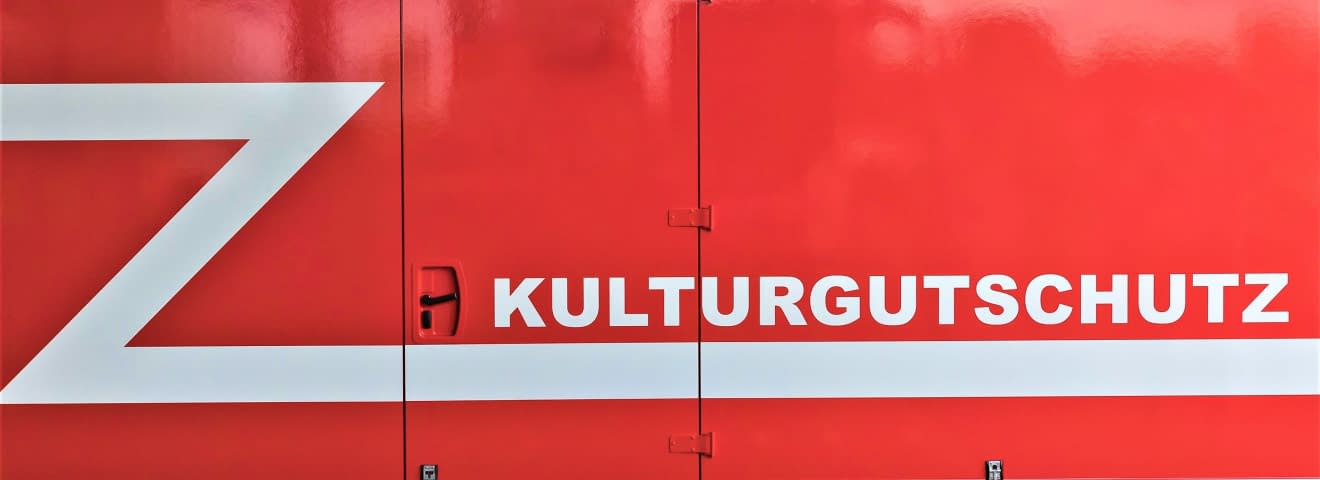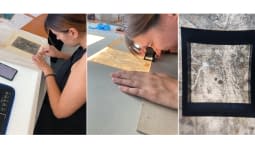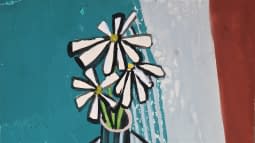Conservation of endangered cultural assets and the protection of cultural heritage
What is a museum without its art? A gallery without its artists? Ukraine's UNESCO World Heritage without its sites, monuments and cultural assets?
Every war means an attack on the country's cultural heritage and a robbery of identity and history.
Within the context of the war between Ukraine and RussiaIn the works of art are taken off the walls and out of the showcases to be packed into boxes and crates as quickly as possible, deposited in dark cellars in order to protect them from the armed forces. Outdoor sculptures and figures, monuments and statues are being sheathed with sandbags, wrapped in foam or covered with wooden boards to protect them from bomb splinters. Blue and white signs are put up to mark monuments and protected cultural assets. Some works of art are transported to other countries. For example, works from Kiev are transported to Austria to be exhibited at the upcoming Venice Biennale. Others are brought from Kharkiv, Kiev or Odessa to Lviv to be taken on to western countries such as Poland or Germany (read: Wie die Ukraine versucht, Kunstwerke zu retten | Kunst | DW | 17.03.2022; Welterbe Ukraine: ″Museen faktisch im Kriegsgebiet″ | Kultur | DW | 09.03.2022). Museums, such as the Ivankiv Museum of History and Local History, or memorials, such as the Babyn Yar Holocaust Memorial in Kiev, are said to have already been destroyed to a great extent (read: How Ukraine is moving to protect its cultural heritage - updated 22 March 2022 | International Institute for Conservation of Historic and Artistic Works (iiconservation.org)).
Museum professionals, art conservators and restorers are challenged more than ever in times of wartime destruction, as they tirelessly try to keep cultural heritage alive at the risk of their own lives.
The crucial role of restorers became clear two years ago after the massive explosion in Beirut in August 2020, since they preserve cultural assets through their specialisation and expertise. While the tragic explosion killed many lives, it also destroyed museums, galleries and private art collections all along the way. In collaboration with the Cologne Institute for Restoration and Conservation Science and Rachel Barker Associates in the UK, BeMA (Beirut Museum of Art) organised workshops on specific restoration techniques and the recording of emergency protocols. More than 1,500 paintings were cleaned and restored during the following restoration project by national and international experts within a short period of time (read: BeMA: on a mission to restore the modern and contemporary art collection of the Lebanese Ministry of Culture | International Institute for Conservation of Historic and Artistic Works (iiconservation.org)).
The important role of this specialised group is also made clear by the courage that all emergency workers have to demonstrate during this time. While others are fleeing the war, they are facing the destructive force and trying to protect the cultural heritage on site. Resources and materials are needed, such as packaging and conservation materials, which are being provided by organisations in the Netherlands, Italy and France.
The question of preserving endangered art and cultural assets seems more relevant than ever in today's world. In fact, the protection of cultural property was already being addressed since the end of the 19th century. Looking back at the history of protecting cultural property, more than 120 years have already passed since the first historic international agreement was concluded in The Hague on 29 July 1899. In 1935, further guidelines followed with the so-called «Roerich Pact», which concerned the protection of artistic and scientific institutions as well as monuments. Then on 21 April 1954, the most important Convention of The Hague took place: The Protection of Cultural Heritage in the Event of an Armed Conflict was established through a convention. More recent guidelines explicitly referring to the protection of cultural heritage were decided on 24 March 2017 in the UN Resolution 2347.
This makes it all the more important to document and digitise the art properly. There are various associations that are already involved in conservation measures for endangered art and cultural assets, as well as newly established networks that are explicitly dedicated to Ukraine's cultural heritage. UNESCO, for example, is increasing protection measures for endangered cultural heritage and is in contact with the Ukrainian authorities to identify cultural sites and mark them as such in order to protect them from the war with the already mentioned blue signs. SUCHO, a new international group of activists formed by researchers, programmers, archivists, librarians and others, is working intensively on the identification and archiving of digital content and data from Ukrainian cultural institutions. Other organisations supporting Ukrainian museums in the preservation of endangered cultural heritage which should be mentioned at this point and are listed below:
ICCROM (International Centre for the Study of the Preservation and Restoration of Cultural Property)
ICOM (International Council of Museums)
UNESCO (United Nations Educational, Scientific and Cultural Organization)
SUCHO (Saving Ukrainian Cultural Heritage Online)
CHIEF ONLUS Cultural Heritage International Emergency Force
SCRI (The Smithsonian Cultural Rescue Initiative)
NEMO (Network of European Museum Organisation)
HERI (The Heritage Rescue Emergency Initiative)
ICRC (International Committee of the Red Cross)
ALIPH (International alliance for the protection of heritage in conflict areas)
Art accompanies and decorates the world. It should be seen and fill up the empty museums and galleries. Those organisations listed above contribute to the preservation of art and therefore need to be heard even more than ever.
Image: CC BY-SA 4.0




